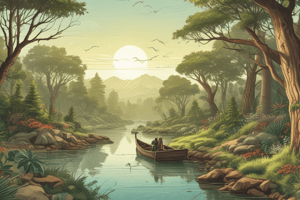Podcast
Questions and Answers
The biosphere includes only the planet's land and water.
The biosphere includes only the planet's land and water.
False (B)
A species is a group of organisms that cannot breed and produce fertile offspring.
A species is a group of organisms that cannot breed and produce fertile offspring.
False (B)
An ecosystem consists only of living organisms.
An ecosystem consists only of living organisms.
False (B)
A community is a group of different species that live in the same area.
A community is a group of different species that live in the same area.
Temperature is a biotic factor that influences an ecosystem.
Temperature is a biotic factor that influences an ecosystem.
A habitat provides only food and shelter to an organism.
A habitat provides only food and shelter to an organism.
A life table is an age-specific summary of the reproductive pattern of a population.
A life table is an age-specific summary of the reproductive pattern of a population.
Abiotic limiting factors such as a storm or a fire are density-dependent.
Abiotic limiting factors such as a storm or a fire are density-dependent.
Commensalism is an interaction that is beneficial for both species.
Commensalism is an interaction that is beneficial for both species.
Mutualism is an interaction that has a negative effect on one species and a neutral effect on the other.
Mutualism is an interaction that has a negative effect on one species and a neutral effect on the other.
Amensalism occurs when both competitors incur a cost.
Amensalism occurs when both competitors incur a cost.
Community ecology examines the interactions within a single population.
Community ecology examines the interactions within a single population.
Autotrophs are organisms that rely on other organisms for their energy and food supply.
Autotrophs are organisms that rely on other organisms for their energy and food supply.
Detritivores are a type of decomposer that breaks down dead or decay matter.
Detritivores are a type of decomposer that breaks down dead or decay matter.
Energy flows through an ecosystem in a circular direction from autotrophs to heterotrophs and back to autotrophs.
Energy flows through an ecosystem in a circular direction from autotrophs to heterotrophs and back to autotrophs.
A food chain is a network of complex feeding relationships among the various organisms in an ecosystem.
A food chain is a network of complex feeding relationships among the various organisms in an ecosystem.
About 50% of the energy available within one trophic level is passed to organisms in the next trophic level in an energy pyramid.
About 50% of the energy available within one trophic level is passed to organisms in the next trophic level in an energy pyramid.
Parasites are a type of autotroph that produces its own food through photosynthesis.
Parasites are a type of autotroph that produces its own food through photosynthesis.
Threatened species are those that are already endangered.
Threatened species are those that are already endangered.
Ecosystem services include only purification of air and water.
Ecosystem services include only purification of air and water.
Habitat destruction is the only major threat to biodiversity.
Habitat destruction is the only major threat to biodiversity.
Species with smaller ranges or poor dispersal abilities are better protected from extinction.
Species with smaller ranges or poor dispersal abilities are better protected from extinction.
There have been only three mass extinctions in the history of the Earth.
There have been only three mass extinctions in the history of the Earth.
Primary succession occurs in an environment where soil already exists.
Primary succession occurs in an environment where soil already exists.
Lichen is an example of a pioneer species in ecological succession.
Lichen is an example of a pioneer species in ecological succession.
Ecology only focuses on the interactions between organisms and their environment at the organism level.
Ecology only focuses on the interactions between organisms and their environment at the organism level.
An animal's niche is the same as its environment.
An animal's niche is the same as its environment.
Biotic factors include sunlight and temperature.
Biotic factors include sunlight and temperature.
Secondary succession occurs after a natural disaster that destroys the soil and the community.
Secondary succession occurs after a natural disaster that destroys the soil and the community.
Flashcards are hidden until you start studying




